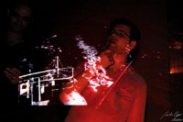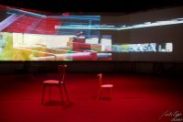Experimental documentation of the participative audiovisual enactment on contemporary issues of the artistic and the political sovereign




text performance susanne gschwendtner / tina muliar / otmar wagner
video camera bernadette stummer
video sampling | editing | sound mix alexandra reill
real-time sound composition eargazm
real-time video stage design peter koger | alexandra reill + audience / guests
idea | concept | text | dramaturgy | mise-en-scène alexandra reill
production kanonmedia | vienna 2012
As much as it is a homage to the oeuvre and attitude of the Dadaist Hans Richter, the documentary Tribute to Hans Richter explores his approaches in the beginning of film history in regard to their contemporary relevance-in a digital age of audiovisual art of the 21st Century. It experimentally reflects the status of contemporary audiovisual creation in historical and political space – whether it is that space Hans Richter created, when he devoted himself to the abstract as the then so-called “pure” form of aesthetics or that political space where he actively acted as an anti-fascist. It is that political space, which probably still today – this time not infrequently capitalist-neoliberally conditioned – comes from inexperience in actively making use of a collective and state-independent sovereign as much as from group dynamic hazards of mitläufer mass movement and economic opportunism.
The experimental film has at last come into its own. It has created its own realm, which we may term “film poetry” in contradistinction to the “novel” of the entertainment film or the “reportage” of the documentary. (1)
If collective communication processes do become effective in restructuring a digital age, and if they have decision-making capacity, then we need to pose the question which political and artistic role decentral experimental film production plays. This question offers itself as an artistic approach to explore the three thematic segments defined by Richter in his manuscript30 Years of Film Poetry as Self-Expression andCommunication, probably written in 1957, as the threepillars of then contemporary filmmaking, and to reflect them in the contemporary light of obviously enormous global changes:
the freedom of the artist;
the moral responsibility of film content;
and the value of the obscure. [a](2)
(1) Hans Richter: EASEL—SCROLL—FILM. In: Magazine of Art, 02/1952, p. 86; cp. also http://rhythmiclight.com/articles/EaselScrollFilm.pdf, date of publication unknown, access: 2011/08/28
(2) Cp. Richard Suchenski: Hans Richter. In: senses of cinema No. 49, http://www.sensesofcinema.com/2009/great-directors/hans-richter/, date of publication unknown, access: 2011/07/17 17/07/2011; [a]: Hans Richter: 30 Years of Film Poetry: Self-Expression and Communication. Manuscript; translation: Alexandra Reill